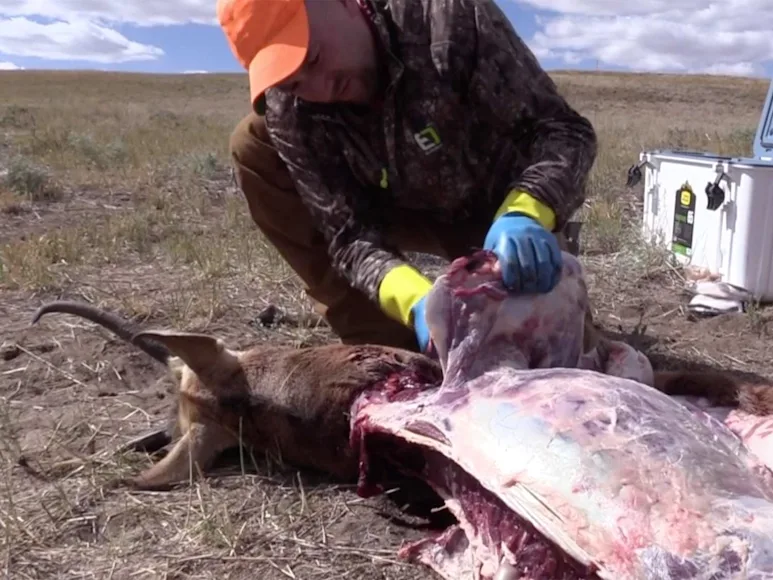The gutless method of cleaning big game is overrated. I’ve said it, and I believe it. Traditional field-dressing—where you yank the guts out of the critter soon as possible—is the better way to go most of the time. Hanging an animal on a gambrel, particularly in a meat locker, is cleaner and easier.
Still, that’s not always possible, and so the gutless method is worth learning for a few reasons. One, it seems to impress the Westies. Two, if you’re in the backcountry and need to quarter and carry an animal out, the gutless method saves you a step and a little mess—though it’s not much faster. Three, if you’re an eastern deer hunter jumping across state lines to hunt, you need to know how to quarter your animals in the field because of CWD-related carcass transport regs. The gutless method is one good way to do that, for the same reasons listed above.
When my buddy Miles and I filmed this video during a pronghorn hunt a few weeks ago in Colorado, we were an hour’s drive from town with one antelope on the ground by midmorning and another tag left to fill. I had a few options on what to do:
Gut my antelope, and leave it sitting in the bed of the truck and 75-degree sun all day, hide-on. That didn’t seem like a good idea.
Gut my antelope, and then quarter it. Not a bad option, except we didn’t have any spare water handy for cleaning up, and I didn’t want to spend the rest of the hunting day caked in blood.
Take my antelope apart using the gutless method, which was the cleanest option available to get my meat into coolers quickly. Plus, I could check off an assignment to make my editor happy, and walk away feeling slightly superior, having successfully avoided touching the nasty offal as a hillbilly Kentuckian normally would.
So gutless is what I chose. I hope you enjoy my effort. Here are step-by-step instructions.
.embed-container { position: relative; padding-bottom: 56.25%; height: 0; overflow: hidden; max-width: 100%; } .embed-container iframe, .embed-container object, .embed-container embed { position: absolute; top: 0; left: 0; width: 100%; height: 100%; }
How to Use the Gutless Method to Field Dress an Animal
Have everything ready. We had brought coolers with bags of ice along, but that’s usually not an option. Bring mesh game bags and plenty of them. They keep the meat clean and protect it from flies, while also allowing good airflow. Set to work with tagging and carcass transport regs in mind.
I like to first remove the legs at the bends of the knees. This is easily done with a sharp knife and a little basic anatomy knowledge.
Make a slice up the rear of the front quarters, to the elbow, and begin skinning away on the leg.
Skin around the hind knee, and make a slice up the rear leg, along the rump roast, diverting around the tailbone.
Carefully make a cut along the spine, next to the backstrap, down to the front of the shoulder blade. Begin skinning this away in a large panel, using the edge of your knife to separate hide from meat, and being careful to avoid getting hair on the meat.
Skin the hide away from the front leg and belly. The rear incision you made initially makes this pretty easy.
Remove one of the quarters. Your choice on which to do first. The shoulder is only attached by connective tissue, and is easy. Place it in a game bag or cooler.
The rear quarter will need to be dislodged from the hip socket. In many states, you’ll need to leave proof of sex attached to a quarter. So, don’t cut the pecker off, and don’t toss the balls in the bushes.
Remove the backstrap as usual. Skin farther up the neck to remove the neck meat, if desired.
Find the floating rib, between the back of the chest cavity and forward of the hip bone. Carefully make an incision along the lower lumbar of the spine, with your knife edge pointed up.
Use your fingers to work between the stomach and spine, where you’ll be able to feel the tenderloin. Using the point of your knife, carefully separate the tenderloin from the spine on both ends, and gently pull it out of the animal.
That complete, flip the animal over and repeat. The process is the same, whether you’re skinning a pronghorn, whitetail, elk, or moose. With practice, you should be able to finish a deer-sized critter in about a half-hour.






